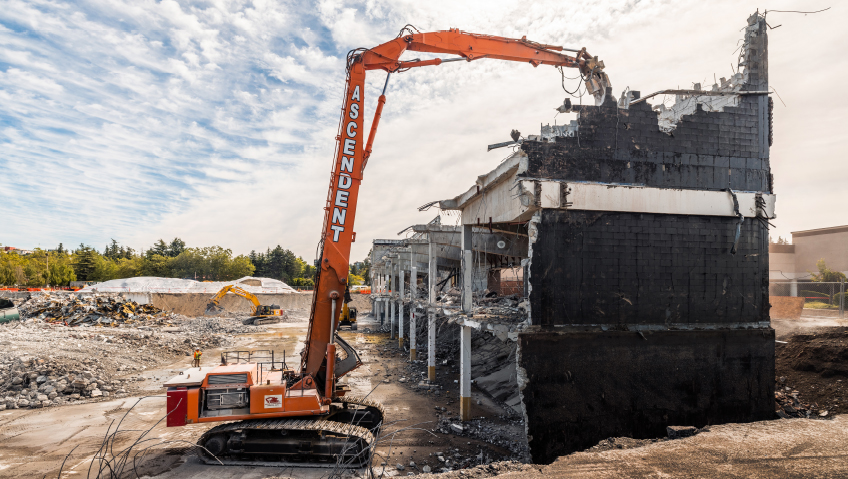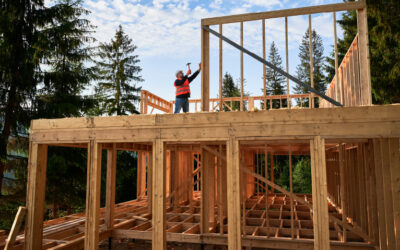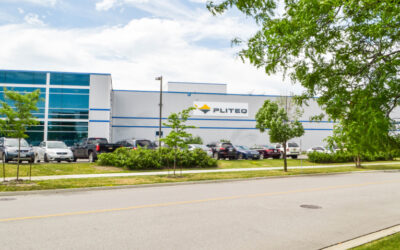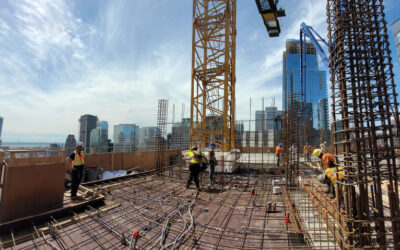Ascendent Demolition, LLC demolishes building interiors and exteriors for a wide range of clients. Based in Puyallup, Washington, this demolition, abatement, and civil contracting firm uses well-trained crews and a fleet of excavators, skid steers, and other equipment to perform its tasks.
Contrary to popular perceptions about how building demolitions are done, Ascendent approaches its assignments with caution, finesse, and a safety-first focus. Demolition work also frequently involves the recovery of recyclable material and the removal of hazardous material.
“We’ve never used a wrecking ball at Ascendent and we’ve not used dynamite. Today’s demolition contractors use a lot more precision than they did in the past,” states company founder and owner, Rick Estes.
He explains that Ascendent performs both total and selective demolition. “Selective demo is when you go in and strip the flooring, the ceiling. You gut all the interior walls, the electrical systems. You might cut holes in the floor; that’s select demo. With total demo, you remove the structure in its entirety,” says Estes.
Regardless of the assignment, Ascendent’s crews carefully scrutinize any buildings slated for demolition before commencing work. Besides looking for potential safety issues, crews study structures and building plans for hazardous materials. About 90 percent of the buildings the company works on contain hazardous material, usually asbestos, says Estes, often found in the flooring, pipe insulation, and even on popcorn ceilings in older buildings. Asbestos needs to be extracted before the building comes down, along with Polychlorinated biphenyls—PCBs, toxic substances commonly used in building materials for much of the 20th century—lead, and contaminated soil.
While the company doesn’t seek out such work, Ascendent will “perform asbestos-only projects without demolition,” adds Estes.
The state of Washington sets high standards for asbestos removal equipment, documentation, and training, and anyone at Ascendent tasked with handling asbestos “has to get a physical to ensure they are physically able to wear respirators—that they are not putting challenges on their pulmonary systems by wearing these respirators,” says Estes.
In addition to abating hazardous materials, another vital task is simply determining a “common-sense place to open up the exterior, so we can put Bobcats into the building. We use Bobcats and skid steers to gut the building, tear down, and push out all the soft material. We’ll push that material out and a machine will load it into trucks for disposal,” he says.
On total demolitions, excavators—sometimes fitted with specialized attachments—are used to demolish the shell of the structure. The excavators “grab the concrete and squeeze, until the concrete yields and turns into gravel. We repeat that process a couple hundred times and the building is gone,” explains Estes.
Debris from such work is not always shipped to landfill; recycled concrete is a valuable commodity that the company tries to preserve during demolition jobs.
Ascendent’s main markets include retail, military, public infrastructure, commercial, industrial, and privately owned buildings. The latter, alongside civil infrastructure demolition, bring in the most revenue at present, states Estes.
While the company doesn’t have any branches outside of Puyallup, “we are looking to expand geographically, to Montana, Idaho, and Oregon,” says Estes. “We are licensed in Idaho and do perform work there on occasion, if there’s a job that fits our expertise.”
Estes, who had experience working with a different demolition company early in his career, founded Ascendent in 2001. Like most young demolition companies, Ascendent primarily did selective demos at first. “When you decide to get into the demolition business, you really only have one avenue, and that’s going to be the selective demo,” Estes explains.
Typically, demolition companies require a solid reputation, experienced staff, and lots of top-notch equipment before clients consider them for total demolition work. Ascendent began doing total demos about eight years ago and such jobs now account for over half of the company’s workload. “I think we’ve probably got several million dollars invested in our equipment at this point. It just takes a long time to get there,” notes Estes.
Ascendent’s equipment fleet includes over 32 excavators, some weighing up to 90 tons, from Japanese OEM Komatsu, with six high-reach excavators including one with 135 feet of reach. The company employs 120 field workers and roughly 22 additional staff members at its headquarters, the latter including mechanics, warehouse workers, and project managers. In most demolition companies, estimators make bids while project managers supervise the actual labor; at Ascendent, these roles are combined—the person who does the estimate takes on the role of project manager if the bid is accepted.
This arrangement “represents our interests as well as the project owner’s interests better. Things aren’t missed from the bid period, and there are no questions. We understand what the client needs. The project manager is invested in the job because he’s the one who put the bid in,” explains Estes.
Even without TNT and wrecking balls, demolition work can be risky. To enhance its already impressive safety standards, Ascendent hired a full-time Environmental Health and Safety (EHS) manager at the beginning of this year.
“Because of our crew sizes and the number of projects, we made the commitment to add a designated safety professional to our staff. Work injuries unfortunately do happen. When they happen, we [help injured staff] get back to work… We find them light duty things to ensure they’re staying employed. We have retraining programs too. Safety is very big at Ascendent,” says Estes.
The company also has “quarterly superintendent meetings” during which staff talk for “a couple hours about what’s been going on, and get feedback from the superintendents… Maybe there’s some new technology or product we should be looking at. We try to stay abreast of new trends, whether it’s safety or production,” he continues.
Over the years, Ascendent has taken on some very high-profile projects, including work at a former sugar refinery in Moses Lake, Washington. Ascendent worked on a pair of very tall steel buildings that were part of a facility that processed sugar beets from the 1950s through to the late 1970s. Tasked with taking down and cutting up approximately four million pounds of steel, Ascendent finished this mammoth project in early June of this year.
Another project, for MultiCare Mary Bridge Children’s Hospital & Health Network in Tacoma, Washington, aptly demonstrates Ascendent’s demolition skills. Here, the company was responsible for removing 250,000 square feet of structure in preparation for the hospital’s upcoming expansion and new, state-of-the-art pediatric campus. The site in question was over three acres in total size, with three separate buildings, a three-story concrete parking garage, a six-story brick and concrete structure, and a five-story concrete structure.
Taking place in the heart of an active hospital campus with only one way in and out, the work had to be carried out with meticulous attention to detail. It required intense coordination to keep active oxygen lines operational adjacent to the demolition activities, while extreme dust suppression measures had to be undertaken due to patient sensitivity. Ascendent’s team employed dust cannons, to resounding positive feedback from the client/owner.
Over 12,000 man hours went into the Mary Bridge project, with specialty excavators and attachments utilized to great effect. In the end, the project enjoyed a 93 percent project recycle rate, with 21,000 tons of materials being recycled.
With an eye on future growth, Ascendent takes a proactive role when it comes to promotion, and makes heavy use of social media, particularly LinkedIn. “We are very active on LinkedIn in promoting our brand there,” says Estes. “We encourage project managers to participate on LinkedIn and share their project successes.”
Ascendent also gets its name before the public by participating in local community golf tournaments and by branding its new equipment. “We paint the counterweights on the back of all of our excavators bright red. We put a sign on the back that people can see a mile away and go, ‘Oh! That’s an Ascendent machine over there!’ It helps with brand recognition,” explains Estes.
For all of Ascendent’s success, the company does face certain challenges, including finding qualified field labor. Across North America, industries and manufacturers are faced with a shortage of new workers to replace existing staff who are reaching retirement age. “We’re feeling the pressure. I don’t think the younger generation is being drawn to the construction trades like it was in the past,” notes Estes.
Attracting qualified staff ties in with another challenge: maintaining workload. Ascendent has grown enormously, which is good for the bottom line but means there’s a constant need to secure new projects.
“It wasn’t that many years ago, if we had 45 or 50 guys in the field and 10 machines working, everybody was happy. Now we’ve got 35 excavators, and they all need to keep going, and [over] 100 field guys. That’s why we invest so much in marketing,” says Estes.
The company has branched out before (a separate division called Ascendent Concrete Restoration focuses on “the removal of unwanted concrete coatings, joint and crack repair, leveling, grinding and polishing and general restoration of concrete floors,” says the company). That said, there aren’t any plans at Ascendent Demolition to expand into other new sectors at present.
“I don’t see any drastic moves [going forward] outside of increasing our geography,” shares Estes. “Equipment-wise, we’ve got the fleet we need to be competitive and to take on any challenge that comes our way. It’s just a matter of fine-tuning what we’ve done.”













